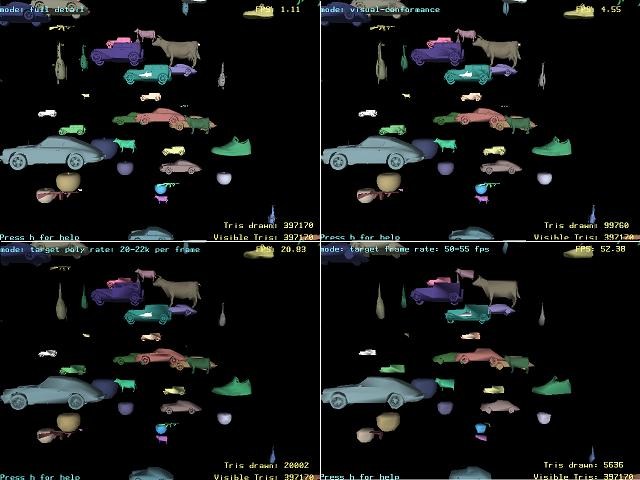 |

Submitted by , posted on 21 November 2002
|
 |

Image Description, by

These screenshots were taken from my undergrad project. The aim of the
project was to have a look at developing a high performance progressive
mesh and explore its application.
The image shows 4 screen shots. Each shot is of the same scene using a
different mechanism to render it. In the top right of each shot the
frame-rate is displayed. At the bottom right the number of visbible
triangles (frustum clipping) is shown, along side the number of triangles
actually drawn (by the rendering mechanism, labeled "Tris drawn").
The screen shots are taken on a horribly old machine (Pentium 200), and
show how the scene rendered at full detail results in a frame-rate of 1.11
fps (top left).
top right: shows a visually conforming rendition, where only as much detail
is removed as to be imperceptible (4.55 fps).
bottom left: distribution of 20002 polygons accross the scene (20.83 fps)
bottom right: shows a system that reduces detail until the fps reaches
50-55k (52.38 fps)
The program shown uses OpenGL and GLUT, and runs under both windows and
linux (well, most *nix).
The data structure I made basically does not touch the vertex list, and
uses the glDrawElements command to fire the objects at the card. The same
reference mesh is used by multiple instaces of the same object.
The mesh is always at some given LOD (level of detail), and has additional
information that allows it to transition incrementally to any desired LOD.
Each level of LOD has an associated error term that allows us to
intelligently distribute polygons accross the scene giving preference to
details that are more important.
As with standard PMs (Progressive Meshes), this incremental data is stored
on disk in most significant to least significant order.
It was basically an excercise at developing a *FAST* PM, and exploring the
ways of making use of it. The best feature of this whole excercise, in my
opinion, is the idea of scalable games:
Basically, because of the ordering of the data, we only need to read as
much information as we are interested in. This means that we can have a
150mb model on disk, but only read 150k of it. Reading that 150k gives us a
lower detail approximation of the full blown model. We then use this in the
game, because the game does not need much detail. However, in the future,
when they get their Geforce-18, the game can read all of the data......
There are a lot of advanced topics that I didn't get to touch, because this
is a "single subject" project... however I will be returning to do
post-graduate work continuing in this area, so hopefully I'll have some
more things to send you guys.
Things are not clear on copyright, so I won't post code/programs, but if
anyone is interested, let me know...
-Alex Streit
|
|

